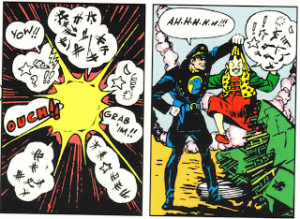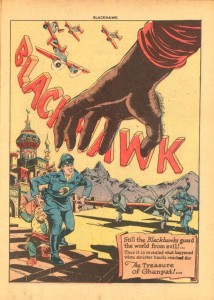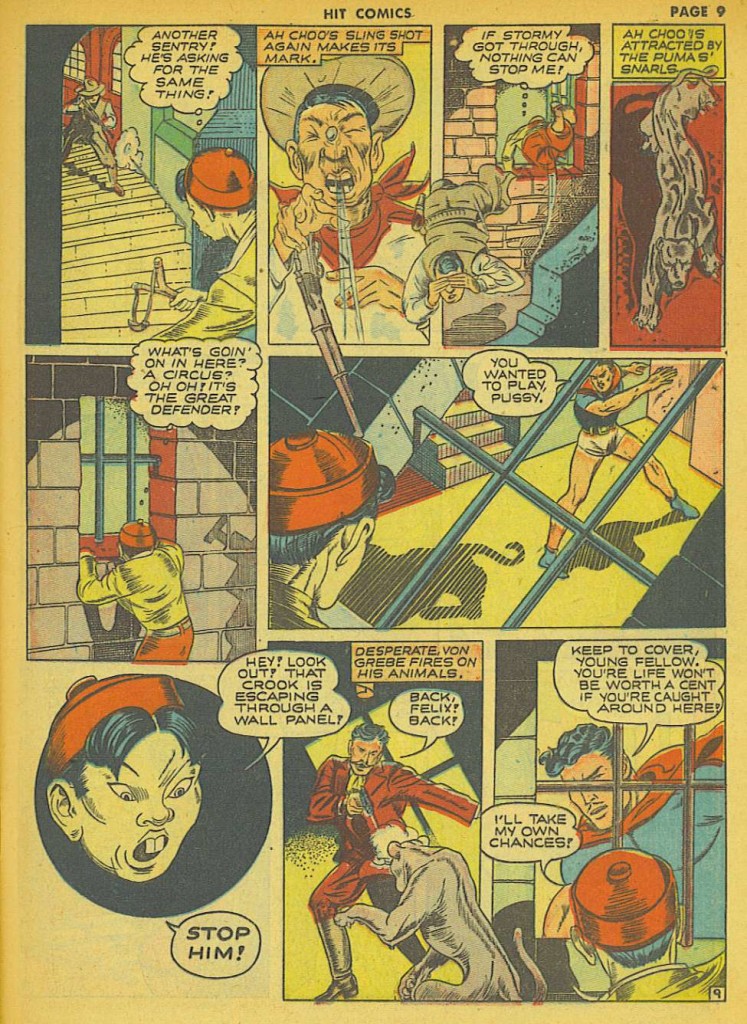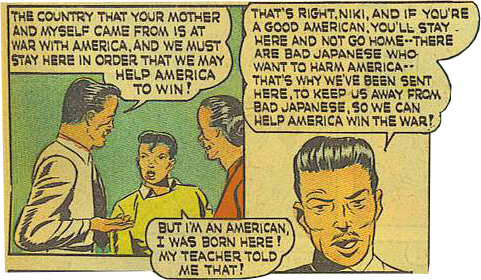In 1941, publisher Quality Comics introduced a new team of military heroes to the American comics scene: the Blackhawks.
The team, introduced in August 1941 in the pages of Military Comics #1, consisted of seven ace pilots who fought against tyranny and oppression from their base on Blackhawk Island. The leader, Blackhawk, was American, while most of the other Blackhawks hailed from different European nations that had been captured by the Axis Powers. And then there was Chop Chop, the only Asian member of the team.

Chop-Chop’s first appearance, in Military Comics #3.
Chop Chop was a Chinese man who made his first appearance in Military Comics #3, published in October 1941. In his debut issue, the tiny, buck-toothed “Chinaman” crash-lands on Blackhawk Island in a self-repaired Nazi airplane, spouting speech bubbles filled with pseudo-Asian scribbles mimicking Chinese characters. After being extracted from the wreckage, the character animatedly warns the Blackhawks about a “Red Closs Nurse in much danger!” The Blackhawks rush off to rescue the damsel, but not before tricking Chop-Chop (who admitted that he didn’t know how to fly a plane) into tying himself up so that he wouldn’t interfere with the mission.
Although officially a Blackhawk by name, Chop Chop spent the first few decades of his existence clearly set apart from the rest of his team. In a universe of realistically-drawn human characters, he was depicted as a colorful, buck-toothed caricature. This jarring contrast is easily seen in the Blackhawks “roster”, published in May 1948 in Military Comics #18.

The Blackhawks roster, from Military Comics #18, published in May 1948.
Initially, Chop Chop’s role on the team was essentially to be the “team pet”, a sidekick to Blackhawk, and a source of comic relief. He did fight enemies, but with a cleaver, brought from the Blackhawks’ kitchen where he worked as a cook.

Chop-Chop the sidekick, from Blackhawk #10. Published 1944.
Although Chop-Chop was certainly a racial stereotype, he was designed to be a lighthearted, humorous character (unlike other wartime comics, which often depicted characters of Asian descent as slant-eyed, sinister enemies). From 1946 to 1945, Chop-Chop starred in his own solo stories, which typically featured the Chinaman humorously bumbling his way through problems while the other Blackhawks are away on missions. The first of these stories was published in the summer of 1946 in Blackhawk #11. In this story, Chop-Chop flies to a “Chinese garden” in Burma on a contraption made of fireworks. There, he accidentally saves an ambiguously Asian woman and receives his first kiss in return, perpetrating the stereotype of the “sexually inferior Asian man” that we discussed in class.
By 1950, Chop-Chop was still very much a caricature. But he was slowly starting to gain normal human proportions, shed a little bit of his racist “accent”, and was taking more active roles in Blackhawk missions. In Modern Comics #98, published in June 1950, Blackhawk himself introduces Chop Chop as the “smartest of all the Blackhawks,” praise which is confirmed after the character suggests using a special explosive to complete a tunnel through a mountain. But, after making his suggestion, Chop-Chop takes no role in the rest of the story, only reappearing on the last page to unmask the villain.
By 1952, things had gotten a little bit better for Chop-Chop, as Blackhawk #50 explicitly stated that Chop-Chop “is now a first-class pilot and a full-fledged member of the Blackhawks team.” But despite his official status, Chop-Chop still lacked the uniform worn by the other Blackhawks, and was still portrayed as a caricature. It wasn’t until DC Comics bought the rights to Blackhawk in the 1960s that Chop-Chop’s evolution really took off.
Blackhawk #197, published in 1964, updated the look of the entire series, and radically redesigned Chop-Chop in the process. He lost his ponytail and cartoony proportions, and traded his colorful coolie garb for the new uniforms sported by the other Blackhawks. He also became a master of martial arts.

Chop-Chop’s new look for 1964. From Blackhawk #197.
Not everyone was pleased with Chop-Chop’s redesign. In 1983, an anonymous staff member of Virginia’s Richmond Times-Dispatch published an editorial in which he lamented the new, politically-correct Chop-Chop and defended the 1940’s depiction as “accurate.” Blackhawk writer Mark Evenir summarized the editorial as follows:
“He (let’s assume it’s a He) complains, “No longer does the Oriental Blackhawk bang no-goodniks on the head with manhole covers, exclaiming: ‘Chop-Chop fixee so face look difflunt!'” The writer loves this kind of stuff and then goes on to explain that to not depict Chop-Chop in this manner is the real insult. He writes, “Since Chop-Chop turned up full-grown in 1941, he might well have been born into a village in which the customs of Imperial China still lingered.” Referring to the fact that Chop-Chop no longer sports the ponytail: “Dequeueing him demonstrates not ‘tolerance’ but cultural imperialism…to the extent that a working class Chinese spoke English, it would be pidgin, not the queen’s…” Translation: The fat, stupid version was historically accurate.”
Evenier was aghast, and devoted much of the letter section of Blackhawk #283 to rebutting this editorial, expressing his amazement that “anyone could believe that Chinese folks were really obese and stupid in the forties.” The controversy that surrounded the Chop-Chop character for decades had finally boiled over, and it was time that the comic address it. Two months after Evenier’s rebuttal, Blackhawk finally confronts their treatment of the character in a fantastic story, What’s The Matter with Chop-Chop?
In this story, which concludes the Chop-Chop saga, the character is back in World War 2, wearing his “Asian clothes” (the Blackhawk universe had been “reset” in the 1970s). Although he is now largely free of the stereotypy that defined him in the earlier decades, the other Blackhawks notice that Chop-Chop seems upset. He is suddenly refusing to do the team’s domestic chores, insisting that he “came here to fight.” The change in Chop-Chop’s demeanor is baffling to the Blackhawks, until, on page 8, a young civilian girl finally asks Blackhawk, “Why does one Blackhawk wear different clothes from the rest?” Blackhawk is unable to answer, and genuinely wonders why Chop-Chop has never been given a Blackhawks uniform.
He then has a flashback to a party that the team had recently attended, where an artist had offered to create portraits for each member of the team. All of the portraits were flattering, until Chop-Chop’s. For him, the in-universe artist decided to have “fun”, and drew a picture resembling Chop-Chop’s racialized 1940s design. To top it off, the artist commented that he has “great respect for you Chinamen. No one does laundry the way you do. And I simply love that fried rice — or as you call it, “flied lice”. The scene ends with Blackhawk angrily throwing the offensive artist through a window.
After the flashback, Blackhawk confronts Chop-Chop, who angrily suggests that the other team members don’t consider him a full-fledged pilot. When Chop-Chop later suggests that he fly a dangerous mission alone, Blackhawk initially refuses, but, in order to quell Chop-Chop’s feelings of inferiority, decides to give him a chance. Chop-Chop pulls off the mission flawlessly, and when he returns, he apologizes for his terse behavior, explaining that he feels as though he “shouldn’t be here”. He tells Blackhawk that he wants to defend his homeland from the Japanese invasion, and is requesting a leave of absence to defend his homeland. But Blackhawk won’t approve his request… …until it is made by someone in uniform. He presents Chop-Chop with a Blackhawks uniform, which transforms the character from a stereotype into a person: Special Retail Officer Wu Cheng. The request for leave is granted, and as Cheng flies off into the sunset, the narrator ends the story:
“Soldiers are all created equal. And yet… and yet, six men are right now feeling that the seventh is maybe a little more equal. At least, today.”
Chop-Chop is a character worthy of our archive because we can use the evolution of his design to trace the gradual evolution of Western sensibilities regarding racial stereotyping. The comic book genre itself provides a good medium for examining these stereotypes, because, as a visual medium, “comics rely upon visually codified representations in which characters are continually reduced to their appearances (Singer, 1).” The design of a character in the world of comics can have wide-ranging effects in “the real world”. In the curator’s note for “This Side of Now” in REVN, Vo Hong Chuong-Dai notes that “the aesthetic is never seperate from the political and the social (Chuong-Dai, 60).” In Blackhawk, the characters serve as representatives of their respective nations of origin. The blatant visual differences initially existing between Chop-Chop and his European/American teammates deliberately “othered” the Asian character to the point that he was “equal” in name only — a predicament that far too many minorities experienced, and continue to experience, in real life.
 Secret Identities: The Asian American Superhero Anthology
Secret Identities: The Asian American Superhero Anthology  In this comic, stereotypes are thrust upon Jeff Yang as a child, for while Superman’s story parallels the Asian American experience, his friends force him into those narrow stereotypes. After deciding to create this anthology, Yang narrates, they turn to embrace those stereotypes, specifically the kung-fu and karate kid ones, presumably because they scare away some racist guys trying to start a fight with them. By using what typically oppresses them, they empower themselves. It becomes a sense of racial pride.
In this comic, stereotypes are thrust upon Jeff Yang as a child, for while Superman’s story parallels the Asian American experience, his friends force him into those narrow stereotypes. After deciding to create this anthology, Yang narrates, they turn to embrace those stereotypes, specifically the kung-fu and karate kid ones, presumably because they scare away some racist guys trying to start a fight with them. By using what typically oppresses them, they empower themselves. It becomes a sense of racial pride. Racist caricatures of Asian Americans comes from a history of colorism, which in turn inspires a need for Asian Americans to hide their ethnic identities. In response to this, As Schlund-Vials says, there is “the need for ‘Yellow Power,’ a new ‘way of life’ built on anti-racist revision, progressive re-imagining, and unapologetic racial pride.”
Racist caricatures of Asian Americans comes from a history of colorism, which in turn inspires a need for Asian Americans to hide their ethnic identities. In response to this, As Schlund-Vials says, there is “the need for ‘Yellow Power,’ a new ‘way of life’ built on anti-racist revision, progressive re-imagining, and unapologetic racial pride.”


















